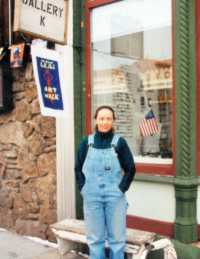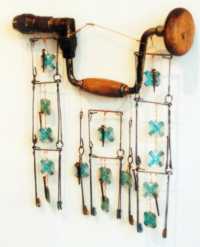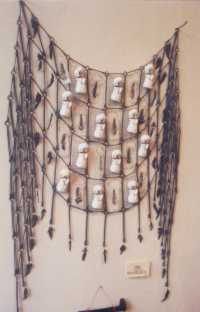Article by Sue Snively
Local artist – April 2002 – Colorado Central Magazine
IT IS CALLED “Prayer Shawl” and it hangs in the sunlight at Gallery K on F Street in Salida. Framed in a bed-spring hung to look like a shawl, are 12 small sculptured figures of a sad, young woman. Tiny discarded feathers and a few bold birds are interwoven with the statues within the squares of the bed-spring. Delicate feathers at the dangling ends of the spring contribute to the rather soft, feminine appearance of the piece.

The multimedia artist and gallery owner is Kay Litz of Salida. In “Prayer Shawl,” as in most of her work, Kay has managed to give value and class to what she terms “junk.”
Most of Kay’s pieces start with a single discard and evolve from beginning to end around that discard. In the case of “Prayer Shawl,” the fundamental object was the bed-spring which Kay found in a landfill. Aside from some rearranging to fit the piece, the bed-spring remains — as do all of her objects — as she found it. Within the spring, Litz chose objects that would blend with the theme she had chosen for the artwork.
“Prayer Shawl” was inspired by a story Litz heard on the radio about the war in Kosovo. The radio program was about a woman who had a beautiful 16-year-old daughter who was killed by soldiers. This woman was thankful that her daughter was killed rather than raped, as it is a very shameful thing to be a victim of rape in that part of the world.
The sad white sculptures of the young girl depict that shame. The feathers and birds, Kay says, are signs of spirituality in some ancient cultures. As with all of her work, the objects in “Prayer Shawl” blend together to form a balanced, symmetrical and very aesthetically pleasing design.
KAY LIKES TO SEE how different materials work together. What would a feather look like on a big bold piece of metal? What range and depth can the different objects give to an overall piece? Litz spends a certain amount of her time strolling through back alleys and dumps, collecting what she needs to develop interesting and pleasing visual forms that viewers can relate to.

Proof that she puts things together in a way that catches the eye of the observer (and of the art critics) came recently when Litz received notice from the state of New Mexico that she had been chosen as one of the artists in their “Acclaimed Artists Series.” The coordinators of the program will be purchasing a large piece of hers to go into one of the state’s public buildings.
There is definitely a Western and Native American flavor to Kay’s work as well as an East Coast and international influence, stemming from her diverse background. Litz was born in Casper, Wyoming, but has lived much of her life in Colorado. Her father was in the oil business and because of his work, the family spent more than a year in Tripoli, Libya and over three years in Bogota, Columbia. Kay attended Brigham Young University where she studied chemical engineering and business, and finished her degree in finance at the University of Colorado at Boulder. She worked for several years in Denver, two in the oil industry and five in commercial real estate, taking art classes at night and on the weekends.
IN 1991, LITZ moved to Philadelphia to attend the Pennsylvania Academy of the Fine Arts full time, and she returned to Colorado in 1994. She pursued her art in a small space in a pottery studio while making ends meet working as a ski patroller and maintenance person in Breckenridge. In 1999, she moved to Salida and opened Gallery K.
Litz sees her work as something of an autobiography. Each piece is influenced by her life and thoughts at the time of its creation.

“My art has changed along with me throughout my life,” she says. “I look at pieces I created a decade ago and am reminded of that time in my life. I can see my own growth by comparing my older pieces to my newer work. Each piece I create is like a microcosm of life itself: I have an idea of what I want to do, I begin the piece, and as I’m working the original idea changes and evolves, as some things don’t work, and other ideas present themselves — sort of like life itself.”
Kay says of Salida, “It is a pleasure to be in an art community that offers such support. There is competition for the dollars, but because of the different things each artist has to offer, that support remains. People come to enjoy all the fine galleries and fine restaurants. It is exciting to see the continuing evolution of the art world in the town.”
Besides the New Mexico honor, Litz has earned many well deserved awards in Colorado, including Best of the Show in 2000 at the Open Awards Exhibit sponsored by the Chaffee County Council on the Arts. In 1999, she received the Meritorious Award at the Colorado State Fair and in 1997 received Best of the Show and the Juror’s Choice Award at the same fair. Besides her own gallery, she has had her work on display in other galleries and locations.
Kay finds that her pieces, which combine materials of differing colors, textures and characters, are inspired by her life experiences. Her time in South America greatly affected her aesthetic vision, and clothing and items of decor that her parents purchased from the native South American people still nourish her artistic inspiration today. The crafts of the native people from the American West, particularly Colorado, have also influenced Kay’s thinking and her work. Balancing those influences, is the inspiration she gained from exposure to the “Classic art” on the East Coast.
Youthful experiences also inspire her work. The macrame skills Litz learned when she was young are still with her. Her aunts and her grandmothers quilted, and in each of her pieces she sees that her use of patterns and forms grew from the sculptured quilts of her past. In art school the wood and metal shops were heaven to Litz because they had huge bins of scrap and junk.
CURRENTLY her scrap bins are found in back alleys and local landfills. Recently Kay purchased land in the San Luis Valley and was delighted when she learned there was an abandoned “dump” on the property. It is the nature of her work to take junk from dumps and change the way people look at it. It is a means of giving value to discards and, in the process, turning them into exquisite works of art.
If Kay were to give advice to artists starting out in the field, it would be: first, to get a day job; and second, to listen to input from other people, but to keep following your own instincts and going your own way. It’s important to maintain your own vision.
And by example, Litz offers a third lesson: she has made the most of her life experiences.
“It all gets mixed in the soup and you learn and grow as you go,” she says. “Evolving as an artist is like evolving as a person. You see a lot, listen a lot, and do what you are supposed to do. Then you hit ‘stride’ and come into your own and become a person or an artist on your own terms. At that point you can stop thinking about what other people think and just do your own thing.”
Sue Snively is a retired teacher who likes to bicycle, climb mountains, and ride motorcycles. Her husband Frank Snively, who took the photos for this article, is a retired physicist, not a photographer, but he can point the camera where he is told.

